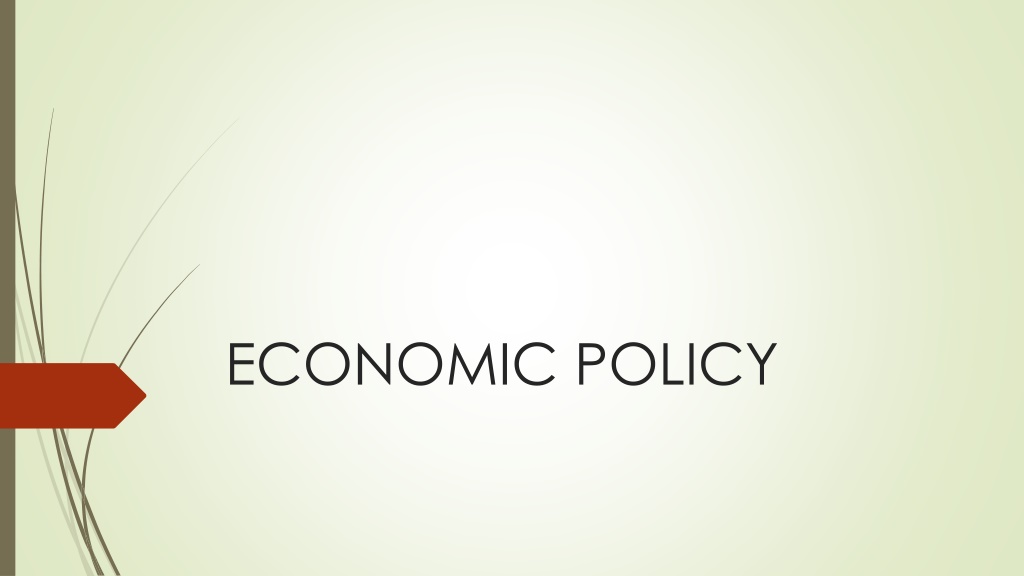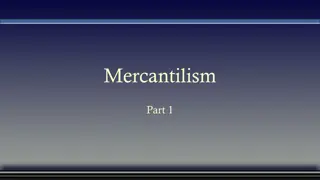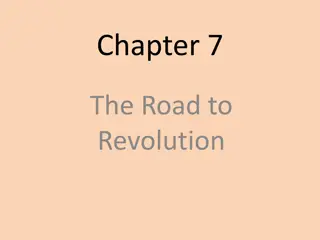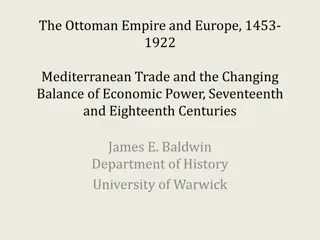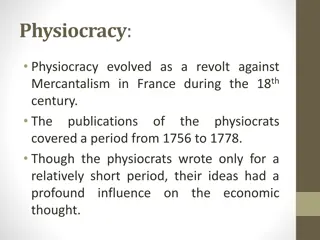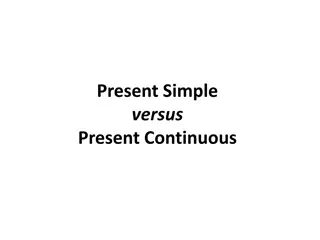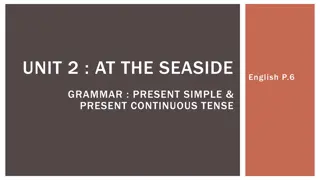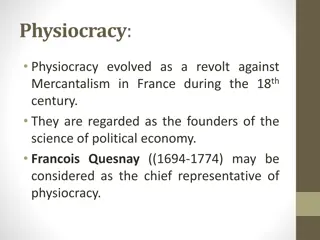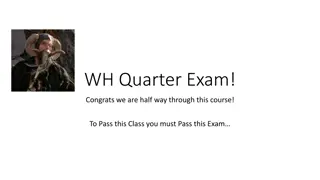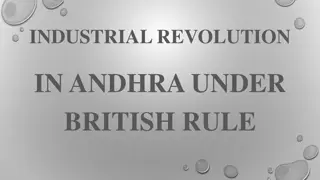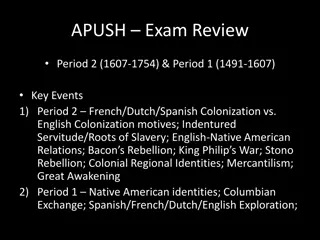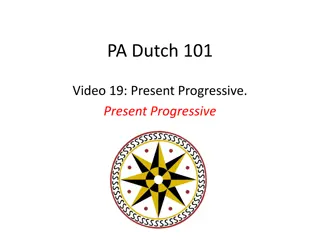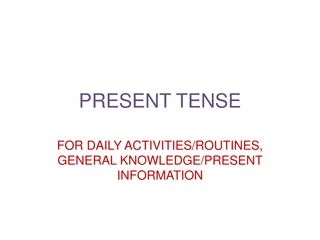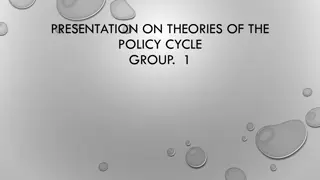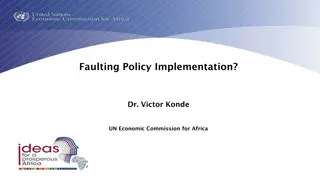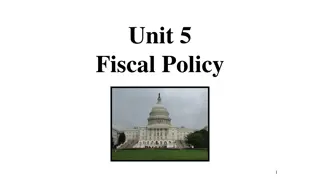Overview of Economic Policy: From Mercantilism to Present-Day Practices
Explore the concept of economic policy and its importance in achieving economic objectives. Delve into the historical debate on state intervention in the economy and major schools of economic theory like Mercantilism. Understand the emergence of economic policies through economic, political, scientific, and cultural factors.
Download Presentation

Please find below an Image/Link to download the presentation.
The content on the website is provided AS IS for your information and personal use only. It may not be sold, licensed, or shared on other websites without obtaining consent from the author. Download presentation by click this link. If you encounter any issues during the download, it is possible that the publisher has removed the file from their server.
E N D
Presentation Transcript
What is economic policy? Policy is the measures taken and practices implemented in order to achieve the predetermined goals. Similarly, Economic Policy is the measures taken and practices implemented in order to achieve certain economic objectives. In other words, Economic policy is the legal and institutional arrangements that states have to achieve in order to achieve certain goals and objectives.
Economic Policy and State The relationship between the state and the economy has been a debated topic in economics from past to present. It can even be said that the history of economics is the history of the struggle of those who defend the state's intervention in the economy and those who oppose it. If you adopt economic policy practices, you think the state's intervention in the economy is necessary. Even in today's most liberal economies, states intervene in their economies when they consider that it s necessary.
Major Schools of Economic Theory 1-Mercantilism The dominant system of economic thought that prevailed in Europe from 16th to 18th Century was Mercantilism. Mercantilist policies are policies that advocate state intervention. It was known by different names in different countries. In England it was called as commercial system or mercantile system because it emphasised the importance of commerce and free trade.
In France it was known as Colbertism after the name of Colbert, the Finance Minister of Louie the XIV. In Germany and Austria it was called Cameralism . It was also known as Bullionism because of the importance given to gold and silver. It was also known as Restrictive system because its practical policies consisted of numerous restrictions and regulations on commerce.
Some economic, political, scientific and cultural factors were responsible for the emergence of mercantilism. 1-Economic factors: Towards the end of the 15th century changes were taking place in the economic life of the people. Domestic economy was giving way to an exchange economy. Agriculture was giving place to industry. Trade became very important and it changed the foundation of socio-economic set-up of the middle ages. Trade necessitated the use of money which was available in the form of gold and silver. Along with the expansion of commerce there were improvements in transport, agriculture, population, etc., so the Mercantilist thought was the outcome of these developments.
2- Political Factors: Towards the end of the middle ages nationalism became the strong force. Europe changed greatly due to Renaissance. As a result, there was a fundamental political change. It resulted in the emergence of strong nations like England, France, Spain, etc., Feudalism came to an end and the King became more powerful. Each nation wanted to preserve its independence and considered other nations as enemies. In order to create a strong and powerful state the Mercantilists tried to regulate the political and economic activities of the people
3) Scientific Factors: In the field of science and technology great improvements and inventions were made. The discoveries of compass and printing press were of great importance, with the help of compass navigation became easier and it led to the discovery of new countries. Thus new countries opened the gates to a variety of raw materials and markets. The invention of printing press helped the spread of new ideas and knowledge.
4-)Culturally also Europe was undergoing a sharp change. Renaissance gave a new light of learning to the people. People were made to realise that this worldly life was more important than the heavenly life. As a result, money came to occupy an important place in human activities.
Main features of Mercantilism 1) The source of wealth is money. Therefore, countries that want to prosper must have precious metals such as gold and silver. 2) Wealth of world is stable. In other words, while one country is getting richer, the other is getting poorer. For this reason, policies towards accumulating more precious metals should be implemented. 3) The state should take an active role in the economy. According to this view, it is essential to have an interventionist state that will implement protectionist policies for foreign trade surplus.
4) Since the aim is to give foreign trade surplus, exports should be more than imports. So exports should be encouraged. 5) Import should be prohibited, as this will lead to precious metal outflows from the country. Only raw materials and skilled labor can be imported. 6) The state must have a strong army and navy. In a period when geographical discoveries and colonial activities are in the foreground, a strong army is essential to obtain new colonies and control trade.
It is observed that these policies will not work in the long term, as the foreign trade surplus will always be gathered on the same side, and will cause harm in the long run. The impoverishment of some countries reduced trade, and the enrichment of some countries caused inflation.
Physiocracy Physiocracy is the collective name of those economic principles and policies which developed in France in the middle of the 18th century. Physiocracy may be defined as a reaction against Mercantilism and its concepts. The physiocrats believed that the mercantile policies instead of doing any good have done great harm to the nations. So they revolted against the mercantile policies.
The influential French School of thinkers of the early 18th century was led by Quesnay and Turgot . So, Quesnay and Turgot can be seen as the major thinkers of Physiocracy. They believed in the existence of natural law which governs the universe. They gave special emphasis on agriculture so, their system of thought was sometimes called as agricultural school .
Main Ideas of Physiocracy Mai ideas of Physiocracy are in contrast to those of Mercantilism as follows: 1- Natural order Natural order has been defined by the physiocrats as the order made by God for the welfare of mankind. It is universal and unchangeable. According to the physiocrats the natural order is an ideal order given by God. It is different from the positive order made by men. In other words, the society which is governed by the laws of nature is an ideal society and the society which is ruled by positive laws made by the Government is an imperfect society.
2- Individualism and laissez-faire The physiocrats, especially Turgot, believed that self-interest was the motivation for each segment of the economy to play its role. The individual who tries to maximize his own interests also increases the welfare of the society. Laissez-faire, laissez-passer is a French expression that translates as let do, let pass , that is letting things work on their own.
3-The unique productive sector: Agriculture The unique productive sector is agriculture according to this view. Nature has power to create from nothing. Other sectors, on the other hand, can only change the shape of the factors which were obtained from land. The only thing that the other sectors do is; transformation. Due to these features the only productive sector is agriculture. Hence;the main source of wealth is agriculture
The Tableau conomique (Economic Table) is an economic model first described by French economist Fran ois Quesnay in 1758, which laid the foundation of the Physiocratic school of economics. Quesnay believed that trade and industry were not sources of wealth, and instead in his 1758 manuscript Tableau conomique (Economic Table) argued that agricultural surpluses, by flowing through the economy in the form of rent, wages, and purchases were the real economic movers.
State intervention is unnecessary. As natural order provides the best for human kind, state has to be limited. Thus, state intervention is unnecessary. If the state does not intervene the economy, problems such as inflation, unemployment will be solved naturally.
Classical economics Classical economics or classical political economy is a school of thought in economics that emerged primarily in Britain, in the late 18th and early-to- mid 19th century. Its main thinkers are Adam Smith, Jean-Baptiste Say, David Ricardo, Thomas Robert Malthus, and John Stuart Mill. Adam Smith's The Wealth of Nations in 1776 is usually considered to mark the beginning of classical economics.
Assumptions of Classical economics Invisible hand The invisible hand is a metaphor for the unseen forces that move the free market economy. The invisible hand is part of laissez-faire, meaning "let do/let go," approach to the market. In other words, the approach holds that the market will find its equilibrium without government or other interventions forcing it into unnatural patterns. Scottish Enlightenment thinker Adam Smith introduced the concept in several of his writings, but it found this economic interpretation in his book An Inquiry into the Nature and Causes of the Wealth of Nations published in 1776. The term found use in an economic sense during the 1900s.
Flexible Prices/wages (full employment) The second assumption of classical economics is that prices are flexible. Price flexibility means that markets are able to adjust quickly and efficiently to equilibrium. While this assumption does not mean that every market in the economy is in equilibrium at all times, any imbalance (shortage or surplus) is short lived. Moreover, the adjust to equilibrium is accomplished automatically through the market forces of demand and supply without the need for government action. The most important macroeconomic dimension of this assumption applies to resource markets, especially labor markets.
The unemployment of labor, particularly involuntary unemployment, arises if a surplus exists in labor markets. With a surplus, the quantity of labor supplied exceeds the quantity of labor demanded--at the exist price of labor (wages). With flexible prices, any surplus is temporary. Wages fall to eliminate the surplus imbalance and restore equilibrium--and achieve full employment. If, for example, aggregate demand in the economy takes a bit of a drop (perhaps due to fewer exports of goods to other countries), then production also declines (temporarily) and so too does the demand for labor, creating a surplus of labor and involuntarily unemployed workers. However, flexible prices mean that wages decline to eliminate the surplus.
The classical economists had a notion that labor and other resources are utilized completely or fully employed. According to classical economists, over-production is a general condition of an economy. Therefore, the condition of unemployment does not occur in the economy. According to them, if the condition of unemployment occurs, it is a temporary or abnormal condition in the economy. In addition, classical economists also propounded that the condition of unemployment occurs due to the interference of government or private organizations in normal mechanism of market forces.
Perfect Competition Markets are generally in the feature of Perfect Competition in Classical View. The model of perfect competition is based on the following assumptions. I. Large numbers of sellers and buyers II. Product homogeneity III. Free entry and exit of firms IV. Transparency: Perfect knowledge
Say's Law The other assumption of classical economics is that the aggregate production of good and services in the economy generates enough income to exactly purchase all output. This notion commonly summarized by the phrase "supply creates its own demand" is attributed to the Jean-Baptiste Say, a French economist who helped to popularize the work of Adam Smith in the early 1800s. Say's law was a cornerstone of classical economics, and although it was subject to intense criticism by Keynesian economists.
This law, first and foremost, directed attention to the production or supply- side of the economy. That is, focus on production and the rest of the economy will fall in line. Say's law further implied that extended periods of excess production and limited demand, the sort of thing that might cause an economic downturn, were unlikely. Economic downturns could occur, but not due to the lack of aggregate demand. Classical economy is a supply-sided approach.
The source of value is labour This approach suggests that the value of a commodity was determined by and could be measured objectively by the average number of labor hours necessary to produce it.
Neutrality of Money Money is neutral: money has no effect on real variables. Money demand is transactionary (i lem/m badele ama l ) according to this view. In other words, people prefer to be liquid for day-to-day expenses. The amount of liquidity desired depends on the level of income, the higher the income, the more money is required for increased spending. This is called transactionary demand.
Specialization increases efficiency. A.Smith emphasizes that specialization increases efficiency. The main cause of prosperity, argued Smith, was increasing division of labor. Smith gave the famous example of pins. He asserted that ten workers could produce 48,000 pins per day if each of eighteen specialized tasks was assigned to particular workers. Average productivity: 4,800 pins per worker per day.
Government intervention is unnecessary (due to invisible hand metaphor) according to this school.
Neoclassical economics The term neoclassical economics was coined in 1900. William Stanley Jevons, Carl Menger, L on Walras, Alfred Marshall, Franncis Y. Edgeworth, Arthur Pigou, Wilfred Pareto, Irving Fisher are the major Neoclassical economists.
Assumptions of Neoclassical Economics Neoclassical economists believe that a consumer's first concern is to maximize personal satisfaction. This theory coincides with rational behavior theory, which states that people act rationally when making economic decisions. Main agent is homoeconomicus. Full and perfect knowledge: People act independently on the basis of full and relevant information.
The forces of supply and demand create market equilibrium. The neoclassical school states that savings determine investment. The source of value is utility.The change in economic theory from classical to neoclassical economics has been called the "marginal revolution" as utility has become forefront.
In regard to pricing under perfect competition, two main approaches have been adopted. One approach has been followed by famous English economist Alfred Marshall who adopted the partial equilibrium approach and the second approach has been adopted up by Walras and is called general equilibrium approach. Marshall s Partial Equilibrium Analysis: In partial equilibrium approach to the pricing, we seek to explain the price determination of commodity, keeping the prices of other commodities constant and also assuming that the various commodities are not interdependent. The assumption of ceteris paribus, a Latin phrase meaning "while other variables(things) are held constant
Walras General Equilibrium Analysis: In general equilibrium analysis, put forward by French Economist Walras the price of a good is not explained to be determined independently of the prices of other goods.
KEYNESIAN ECONOMICS Keynesian economics developed during and after the Great Depression from the ideas presented by Keynes in his 1936 book, The General Theory of Employment, Interest and Money. Keynesian economics (sometimes Keynesianism, named for the economist John Maynard Keynes) are various macroeconomic theories about how in the short run and especially during recessions economic output is strongly influenced by aggregate demand (total spending in the economy).
The classical and the neoclassical economists almost neglected the problem of unemployment. They regarded unemployment as a temporary phenomenon and assumed that there is always a tendency towards full employment. It was Keynes who led a vigorous and systematic attack on the traditional theory of employment and replaced it with a more general and more realistic theory. Keynes main criticism of the classical theory was on the following two grounds: (a) The classical prediction that full- employment equilibrium will be achieved in the long-run was not acceptable to Keynes, who wanted to solve the short run problem of unemployment. According to Keynes, in the long-run there is no problem; in the long-run, we are all dead.
(b) Keynes criticised the classical assumption of self-regulating economy. The great depression of 1930s led Keynes to believe that full employment equilibrium in the economy was not be automatically achieved in the short period; and that government intervention was necessary to tackle the problem of the economy. Keynes theory of employment is called the effective demand theory of employment. According to this theory, unemployment arises due to the deficiency to effective demand and the method of remove unemployment is to raise effective demand.
ASSUMPTIONS OF KEYNESIAN ECONOMY Keynesian economics is demand-sided economics. They reject Say Law. Keynesian analysis is short-term analysis. Underemployment equilibrium is prevalent in the economy. Keynesians reject full-employment situation.
Keynesians accept price-wage rigidity. Keynes argued that prices and wages are not flexible as the classical theory asserts. Wages tend to be rigid on the down side because workers will not accept wages which do not permit them to live adequately; this is reinforced by the actions of unions. There are 3 types of money demand in Keynesian analysis. 1. Transactionary money demand 2. Precautionary money demand 3. Speculative money demand
Keynesians reject Quantity Theory of Money. According to them, velocity of Money is not stable (or constant), it is unstable. The engine of growth is spendings. An increase in spendings create rise in national income by the help of multiplier mechanism. They accept savings paradox and liquidity trap.
Keynesians are not opposed to budget deficits, according to them budget deficits can be a solution in various situations. For instance; if the economy is in recession, economic recovery can be created by giving budget deficit. Public debts are not extra-ordinary and temporary financial tools as to Keynesians (as Classical economists asserts). Public debts can be used for eliminating economic disequilibriums.
The most effective policy is fiscal policy. Government (public) expenditures/spendings and taxes are the major fiscal policies. T: Tax rates Id: Disposable Income (Harcanabilir gelir) C: Consumption I: Investment G: Government//public expenditure N: National Income
Economy in Deflation Economy in Inflation Tax policy T , Id , C , I , N T , Id , C , I , N Government/public spending G , C , I , N G , C , I , N
If the economy is in deflation, Keynesians assert that expansionary fiscal policy (geni letici maliye politikas ) has to be implemented. (T , G ) If the economy is in inflation, contractionary fiscal policy has to be implemented. (T , G )
Keynesians say that a downward-sloping Phillips curve should be interpreted as valid for short-run period. A Phillips curve shows the tradeoff between unemployment and inflation in an economy
